Performance Practice
of Electroacoustic Music
Eduardo Moguillansky
zaehmungen #2 v2. bogenwechsel
Eduardo Moguillansky
zaehmungen #2 v2. bogenwechsel (2011)
For string trio with tape bows and ensemble (flute, clarinet, saxophone, piano, percussion)
zaehmungen #2. bogenwechsel was commissioned by the Bayerischer Rundfunk for the Ensemble Mosaik which realised its premiere performance in 2011. The piece is conceived as a “concerto grosso” of sorts [Moguillansky 2019b, 34:20–35:10] with the string trio as the soloist group. As the subtitle “Bogenwechsel” (“bow change”) suggests, the bow as sound producing device is a focal point of this piece. Instead of horsehair the bows of the string instruments are equipped with a strip of magnetic tape containing pre-recorded sounds. The sound is reproduced through a portable cassette player’s tape head fixed to each string instrument at the bridge. “The piece sets to extract features of the bow movement which are not audible under normal circumstances. […] The relationship is inverted: the instrument plays the bow.” [Moguillansky, Program Note] The difference between what one hears and what one actually expects from the tape is instrumental in creating the sense of an illusion insofar as listeners cannot easily determine how the string instruments are able to generate the sounds that are heard. [Moguillansky 2019a, 13:10, 23:05; 2019b 11:20]
The whole construct points to a fundamental question: “How does the bow actually sound?” [Moguillansky, Program Note] The self-constructed tape-bow provides an “indirect” method to answer it: the bow movement becomes audible, something that cannot be achieved using microphones. [Moguillansky, op. cit.] Moguillansky describes this process as a re-contextualisation of traditional bowing skills. [Moguillansky 2019a, 6:36] The investigation of the bowing technique itself turns into musical material [Moguillansky 2019a, 7:45 & 2019b, 9:05–9:20], a fact that according to the composer is also mirrored in the general simplicity of the compositional approach owing to the need to keep the string writing simple in order to be at all playable. [Moguillansky 2019b, 9:38]
The tape contains three different sound sequences in three segments of the bow; at the frog a voiceover narration in English, which is the same for the three bows. In the middle are signal sounds (violin), short fragments about weather and sports from a radio broadcast of Bayern 4 (viola) and a descending scale (cello). At the tip are excerpts from Schubert’s String Trio in B-flat major D 471, the three instruments playing a fragment of their respective part.
Such a device calls for a completely different technique than a standard horsehair bow. The bow must always move strictly in parallel to the tape head in order for playback to occur. Slight and regular bow pressure is required to obtain a clear sound. The pressure only indirectly affects the dynamics, however, too much pressure will cause saturation. Volume is controlled with a pedal. Pitch depends on the bow’s speed and is linked to sound density . A tremolo will produce a “granular synthesis”. (Moguillansky, Program Note) Bow direction and contact point between bow and tape head essentially determine the resulting sound.
In order to compose musical gestures in this setting, specific bow movements must be designed. Moguillansky therefore uses a dedicated staff showing contact point, direction and speed of the bow. It is divided in six sections, two for each tape-bow segment. The musicians are required to execute the prescribed bow movements as accurately as possible, making it necessary to use the tape-bows from the beginning of the practicing phase. [Moguillansky 2019b, 9:50] A simulation with normal bows is pointless.
zaehmungen #2 can be related to pieces exploring movement and gesture as fundamental compositional categories, a concept exemplified by Helmut Lachenmann’s Pression and revisited by younger composers using electronic means and sensors after the turn of the millennium. The modification of the bows is not intended to create augmented instruments integrating data acquisition devices for control purposes, but radically changes sound production conditions in order to experience and understand complex movement constellations involved in instrumental techniques. The investigation of phenomena related to sound production was also the point of departure for Moguillansky’s ensemble piece Panorama/Phantom/Präparat for six instruments and electronics written the same year. Using electronic devices Moguillansky stages experimental settings for all instruments – including the tape bow for the violoncello – to explore phenomena such as sound radiation behaviour (clarinet), delay and filtering through the instrument (trumpet), feedback (trombone), electromagnetic fields (electric guitar) and local timbral behaviour of piano strings. These investigations culminate in a large project entitled Jardin d’Acclimatation, a series of four pieces “focused on quantifying human behaviour based on its acoustic side-effects” in which zaehmungen #2 figures as the opening piece. (https://web.archive.org/web/20210729094144/http://www.moguillansky.info/jardin.html, accesed 16 Nov. 2023) It is this larger context in which the aesthetic-epistemic dimension of zaehmungen #2 becomes evident: bowing movements as instances of human behaviour with an acoustical impact are made perceivable and understandable in a musical context through experimental settings involving electronic means.
The development of the tape bows was a lengthy process. While a similar type of bow had already been used by Laurie Anderson (*1947) in the nineteen-eighties, Moguillansky was not aware of this until after he had created his own his tape bows. [Moguillansky 2019b, 3:40] He developed several prototypes before arriving at the model that is currently used. [Moguillansky 2019b, 8:03–– 8:50]. He also developed a digital version while working at SWR’s Experimentalstudio in Freiburg; a two-channel bow with two sensors capable of making recordings. The sensors allowed to determine which part of the bow had to be played and how much weight was necessary to modify the sound. [Moguillansky 2019a, 17:00]. After this, Moguillansky developed another digital version with an Arduino micro controller, which could record videos. [Moguillansky 2019a, 19:50]
zaehmungen #2 prescribes additional electronic devices, objects, preparations and alternative instruments for the remaining instruments. The woodwind player uses melodicas as well as very peculiar playing techniques; the percussion uses a megaphone and other objects; the piano is restricted to the highest register, which is muted with the exception of four pitches; in addition, the pianist requires a midi keyboard to process the same samples contained in the tapes through granular synthesis. This generates freeze sounds of varying texture and sequences of repetitive impulses, their mechanic sound quality contrasting with the gestural character of the tape bow sounds. Equipped with such a sound arsenal, Moguillansky develops an opposition between the strings and woodwinds mediated and articulated by percussion and keyboard instruments. The omission of expected instrumental sounds and self-imposed limitation give Moguillansky ample opportunity to explore gestural properties through use of an idiosyncratic sound palette.
a) Score
Composer’s edition, 2011
Source: Eduardo Moguillansky
Format: pdf
The score is published by the composer himself . It contains information about the instrumentation and the technical setup, a graphic showing the disposition of the instruments, a flowchart for the electronics and several technical instructions for each instrument. The notation of the bowing techniques and the midi keyboard is thoroughly explained.
b) Other materials
Tape bow processing:
Source: Eduardo Moguillansky
Date: n/a
Author: Eduardo Moguillansky
Format: Reaper session
File: tapebow-noisereduction2.RPP
Remarks: The Reaper session manages all processing for the three tape bows. All plugins used for transformation are part of the default reaper plugin bundle, the only exception being the plugin for the expression pedal, which is provided by the composer. (vstpedal1.vst (OSX and Linux))
Midi keyboard sampler
Sampler/granulation
Source: Eduardo Moguillansky
Author: Eduardo Moguillansky
File: midikeyb.csd
Remarks: The samples used are the same material that is contained on the magnetic strips on the bows.
Audio samples:
VC.wav
VL.wav
VLA.wav
Two folders are provided: original and normalised.
GUI
Source: Eduardo Moguillansky
Author: Eduardo Moguillansky
File name: zaehmungen.pd
Controls:
-grain randomness
-Volume pedal
-Keyboard sensitivity
-Compression
Auctorial Instructions
Sampling
(For an overview of the information contained in the score, refer to –> Sources, score.)
The piano player also controls a sampler with a MIDI keyboard. Sustain and expression pedals are needed. Sampling is realised on an external computer running Linux and configured to use Jack. The sound processing works on Csound. Puredata is used for GUI and Liblo for internal communication thru OSC.
Tape bow
The processing of the tape bow signals is implemented on the Reaper DAW. All plugins used for transformation are part of the default Reaper plugin bundle, the only exception being the plugin for the expression pedal, which his provided by the composer. [c.f. –> Sources, Other material, Tape bow processing]
Processing signal chain
JS: Channel Mixer
VST: ReaEQ (Cockos)
VST: ReaFir (FFT EQ+Dynamics Processor) (Cockos)
VST: ReaGate (Cockos)
VST: ReaXComp(Cockos)
VST: xvolpedal (Eduardo Moguillanksy)
N.B.: The patch for the sampler, the Reaper session, a “read me” document and some other documentation were downloaded from the composer’s website. The “read me” contains an extended version of the equipment list compared to the one found in the score.

Fig. I. Score, technical setup and elements of the signal chain in Reaper
Sound diffusion
Three speakers are prescribed for local amplification of the string instruments, one speaker for amplification of the laptop and one for the slinky and resonator. All types of speakers can be used, studio monitors as well as guitar amplifiers.
The three string players and the keyboard player control the volume with an expression pedal.

Fig. II. Tape bow pickup [Source: https://github.com/gesellkammer/zaehmungen-performance]
The pickups for the tape bows are modified portable tape players (“Walkmen”) with unbalanced stereo output. They have to be connected to DI boxes. The output is stereo; however, the two channels carry the same signal.
The musicians playing the tape bows must be placed as far away from each other as possible; the sounds they produce are quite similar, and the distance will help the listener to differentiate between the parts. This is indicated on the stage plan (“maximum distance”).
The speakers must be placed close to each musician. It is important that the musicians get good feedback from the speaker, as described in the “readme”, in order to be aware of their own dynamic. A corresponding sound level in the venue is necessary.
Performance report
The concert took place on 18 January 2019 at ZHdK’s, main concert hall (GKS 3). Performers were the ensemble Arc-en-Ciel, Simeon Pironkoff, conductor, and Peter Färber, sound projection.
In addition to using DI boxes for the tape bow pickup, it was important to reduce the length of the unbalanced connections. In this way, additional parasite noise could be diminished.
In the signal processing path, a dynamic equaliser for denoising is included. After some testing, it was decided to use an adaptive denoiser from Izotope instead.
The indications in the score concerning the use of the expression pedal are notated just for the beginning and stop at bar 38. The last dynamic information is a fortissimo. The composer pointed out that, even if not notated, it is implied that the players continue to change the dynamic similmente as in the first 38 bars.
The keyboard also has a velocity program. The player can control the dynamics of the sampler with his/her finger technique as well as with the pedal. There is no clear indication regarding the use of the sustain pedal for the sampler.
The percussion player has to scratch the skin of a drum with a megaphone. There isn’t specific information about how to do it. During the rehearsals, the composer explained that this can easily be realised using a megaphone with an external microphone. In this case the megaphone itself can be mounted on a stand pointing to the audience. The percussionist just moves the external microphone.

Fig. III. Score, stage disposition.
Amplification
For amplification five Meyer Sound UPM-1P active speakers were used.
There is no clear information in the score concerning the balance between acoustic and amplified instruments. During the rehearsals, the composer advised that an even balance between them should be achieved. The amplified instruments should be treated as acoustical instruments and should not be too loud.
Most of the time the musicians independently controlled their own dynamic using the expression pedal. During the performance, slight dynamic changes from the FOH were necessary to keep the overall balance.
A microphone symbol for the amplification of the slinky appears on the stage plan in the score. There is no other indication of it. In this performance, a contact microphone was used on the resonator in order to increase the “thunder” effect. If in the venue the sound of the slinky itself is not clearly audible, it may be necessary to use a microphone to enhance it.
Rehearsals
The musicians had the opportunity to rehearse individually with the tape bows. We recommend scheduling individual rehearsals with the whole chain operational. It is important for the musicians to be able to practice with the tape bow, the expression pedal and the signal processing. The system is very sensitive and challenging to control, so that some preparation time is necessary.
As the rehearsals went on, a progressive degradation of the tape bows due to the rubbing on the pickups was noticed. It is important to monitor this degradation to be able to replace the damaged tape ahead of a performance if necessary. Players also need to understand that pressure applied on the bow does not affect the dynamics of the sound and, if exaggerated, can easily damage the tape.
Moguillansky, Eduardo (2019a): Interview. Conducted by Germán Toro Pérez, 17 January 2019.
Moguillansky, Eduardo (2019b): Talk. Given at ICST workshop, 18 January 2019.
Moguillansky, Eduardo (no year): Program Notes. Online: https://web.archive.org/web/20210226001640/http://www.moguillansky.info/zaehmungen.html [last accessed 27 April 2023]
Composer’s website: https://web.archive.org/web/20210226012424/http://www.moguillansky.info/ [last accessed 15 November 2023]
-last updated on 16 November 2023